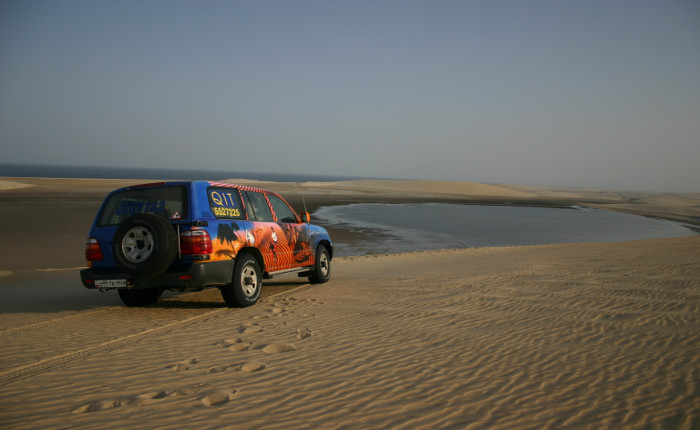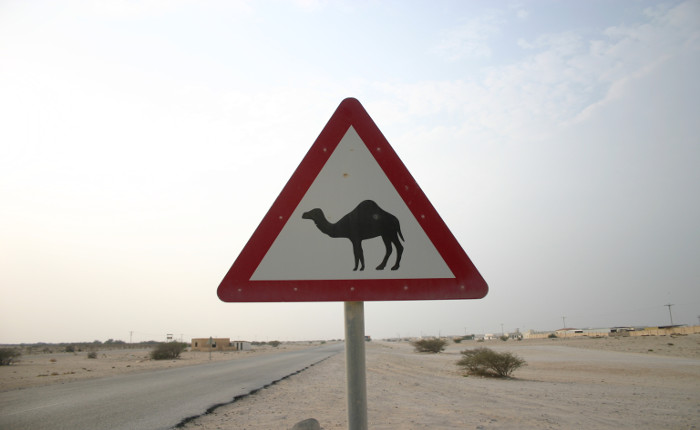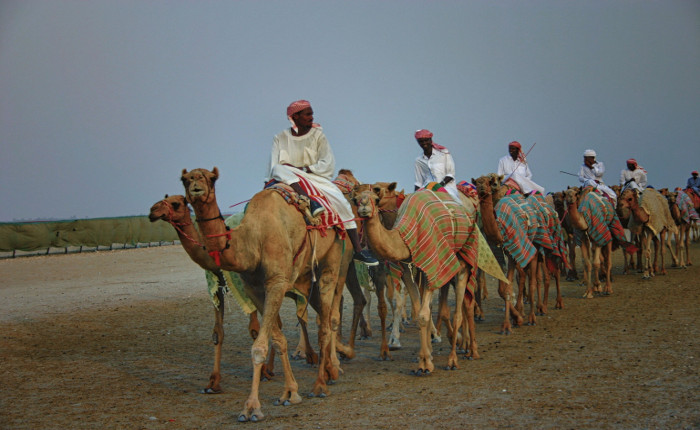"Our ancestors had camels. We have the Landcruiser," smiled Rami.
About an hour south of Doha, Qatar's capital, the tarmac runs out. From here to Saudi Arabia there's nothing but dunes. In the days of those camel riding forefathers, the fierce heat and shifting sands of the desert offered a precarious existence. Today, they're a playground. It was mid-afternoon and the sun was casting an ochre glow across the huge humps of sand.
As soon as we'd reduced the tyre pressure to the correct levels for sand driving, Rami gunned the engine and headed straight for the nearest dune. It was about two storeys high. I checked to make sure my seat belt was done up. We hit the base of the slope and ploughed up, stopping plonk on the top. From our vantage point I could now see the immensity of the space before us. To the right there was a long, wide, flat valley and then more dunes disappearing into the sun. Several more dips and swoops and I'd lost all sense of direction.

Dune bashing is definitely the most fun you can have in Qatar. It's a difficult place to fathom. As I'd stepped off the plane several days previously, I'd felt the muffling wetness of high humidity, but little else. There was no bedlam at passport control, no one trying to run off with my luggage, no invasion of the senses; just a chauffeur-driven BMW easing me to the air-con cocoon of my hotel. My driver was from Pakistan, the girl at the check-in desk Filipino, the bell boy Sri Lankan. I could have been anywhere.
Life in this tiny Emirate, a small peninsula jutting up from Saudi Arabia into the Arabian sea, is very different from the UK. But much remains hidden. Officially the world's richest populous on a per capita basis, thanks to vast supplies of natural gas and oil, Qataris are strict Muslims. They stay hidden behind the walls of their vast houses, the tinted windows of their huge cars, the all encompassing veils that hide their womenfolk.

I asked Rami (originally from Palestine) where all the Qataris were, as we paused for breath on top of a dune. He told me that of Qatar's 800,000 inhabitants, just 25 percent are Qatari, the rest are guest workers from overseas, who live and work here, sending money home. By extension, Qatar's oil wealth supports families in Afghanistan, Pakistan, the Philippines, Malaysia, Sri Lanka and more. There wasn't further time to contemplate this. We were careering down a dune into a valley.
Here the sand was more compact. Rami floored it. We were soon hurtling along at 60 miles an hour. Next we hit a series of dunes, the engine roaring at high revs. Taken at speed they were the ultimate big dipper, my stomach left somewhere in the troughs each time he swooped back up the other side. Perhaps the best manoeuvre was driving round the inside of a long, steep, curved dune, or Barchan as they're known locally.

Next day we drove northwards from Doha on a pristine new highway. I was on a hunt for history, for something to connect me to Qatar. Either side there was nothing but crunchy desert, sullen in the immense heat, punctuated by the odd row of electricity pylons. We stopped first at the old town of Al-Khor. It took just the ten steps to reach the small museum at the harbourside to break sweat. Inside, a series of exhibits traces the history of Qatar's second city, in particular its pearl diving heritage.
Read more > A camel safari in Tunisia
These days the dhows that bump against the harbour walls are only used for fishing. The days when men dived to depths of 20 metres to prise oysters from their beds, with no more than a turtle shell nose peg and beeswax earplugs to aid them, are gone; but the shiny white pearl remains an important cultural symbol. Just across the road I found an old mosque and retreated from the sun into its cool courtyard. With so much oil money around, renovation goes on constantly in Qatar, but here I found a murmur of bygone days.

We pressed on further into the desert. The old fort at Al-Zubara is the best of several dotted around the north of the country. It dates back to 1938, which for Qatar is old. I climbed up one of the square mud-brick watchtowers and looked out across shimmering sand towards a blue smudge of hazy sea. It was a perfect vantage point for repelling raiders.
Several of the rooms inside the fort serve as a museum with displays from local excavations. Five minutes off-road into the desert and we reached the excavations themselves. An old 18th-century city wall and a series of foundations. This memory of an older civilisation looked precarious, ready to disappear once again under the roaming sands.

As we drove back past the fort, Khayal, the old man who worked there as curator, guide and night watchman beckoned us over for a cup of sweet, milky tea. He'd been keeping watch for 25 years. Maybe here I'd found someone who could provide a link between Qatar's Bedouin past and its oil-rich present?
Unfortunately not. He was from Pakistan. He'd arrived in Qatar aged 15 and still sent money home to a family he saw once a year. I wondered if it was a solitary existence out in the desert, but he told me that local Qataris liked to come and sit with him in the evenings and talk. Sometimes he'd set up his battered TV outside and they'd sit and watch together. What were they like, the Qataris? I asked. He assured me they were very friendly, good company. But there was little more he could offer. I'd had a taste of Arabia in Qatar, all sand and blinding sunlight, but its people remained a mystery.
Fancy a Qatar holiday?
Getting there: Qatar Airways flies daily from Heathrow and Gatwick to Doha.
Staying there: There are few cheap hotels in Doha. Most people book packages with operators like Somak (020 8423 3000) who'll put you up in the Sheraton or the Ritz Carlton.
Further info: Qatar Tourist Board: www.experienceqatar.com